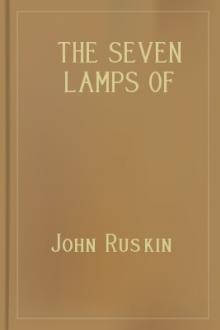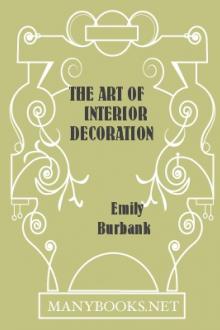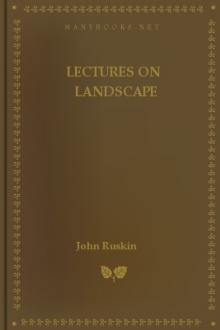The Seven Lamps of Architecture by John Ruskin (books like harry potter TXT) 📕

- Author: John Ruskin
- Performer: -
Book online «The Seven Lamps of Architecture by John Ruskin (books like harry potter TXT) 📕». Author John Ruskin
XVI. Touching the false representation of material, the question is infinitely more simple, and the law more sweeping; all such imitations are utterly base and inadmissible. It is melancholy to think of the time and expense lost in marbling the shop fronts of London alone, and of the waste of our resources in absolute vanities, in things about which no mortal cares, by which no eye is ever arrested, unless painfully, and which do not add one whit to comfort or cleanliness, or even to that great object of commercial art—conspicuousness. But in architecture of a higher rank, how much more is it to be condemned? I have made it a rule in the present work not to blame specifically; but I may, perhaps, be permitted, while I express my sincere admiration of the very noble entrance and general architecture of the British Museum, to express also my regret that the noble granite foundation of the staircase should be mocked at its landing by an imitation, the more blameable because tolerably successful. The only effect of it is to cast a suspicion upon the true stones below, and upon every bit of granite afterwards encountered. One feels a doubt, after it, of the honesty of Memnon himself. But even this, however derogatory to the noble architecture around it, is less painful than the want of feeling with which, in our cheap modern churches, we suffer the wall decorator to erect about the altar frameworks and pediments daubed with mottled color, and to dye in the same fashions such skeletons or caricatures of columns as may emerge above the pews; this is not merely bad taste; it is no unimportant or excusable error which brings even these shadows of vanity and falsehood into the house of prayer. The first condition which just feeling requires in church furniture is, that it should be simple and unaffected, not fictitious nor tawdry. It may be in our power to make it beautiful, but let it at least be pure; and if we cannot permit much to the architect, do not let us permit anything to the upholsterer; if we keep to solid stone and solid wood, whitewashed, if we like, for cleanliness' sake (for whitewash has so often been used as the dress of noble things that it has thence received a kind of nobility itself), it must be a bad design indeed which is grossly offensive. I recollect no instance of a want of sacred character, or of any marked and painful ugliness, in the simplest or the most awkwardly built village church, where stone and wood were roughly and nakedly used, and the windows latticed with white glass. But the smoothly stuccoed walls, the flat roofs with ventilator ornaments, the barred windows with jaundiced borders and dead ground square panes, the gilded or bronzed wood, the painted iron, the wretched upholstery of curtains and cushions, and pew heads and altar railings, and Birmingham metal candlesticks, and, above all, the green and yellow sickness of the false marble—disguises all, observe; falsehoods all—who are they who like these things? who defend them? who do them? I have never spoken to any one who did like them, though to many who thought them matters of no consequence. Perhaps not to religion (though I cannot but believe that there are many to whom, as to myself, such things are serious obstacles to the repose of mind and temper which should precede devotional exercises); but to the general tone of our judgment and feeling—yes; for assuredly we shall regard, with tolerance, if not with affection, whatever forms of material things we have been in the habit of associating with our worship, and be little prepared to detect or blame hypocrisy, meanness, and disguise in other kinds of decoration when we suffer objects belonging to the most solemn of all services to be tricked out in a fashion so fictitious and unseemly.
XVII. Painting, however, is not the only mode in which material may be concealed, or rather simulated; for merely to conceal is, as we have seen, no wrong. Whitewash, for instance, though often (by no means always) to be regretted as a concealment, is not to be blamed as a falsity. It shows itself for what it is, and asserts nothing of what is beneath it. Gilding has become, from its frequent use, equally innocent. It is understood for what it is, a film merely, and is, therefore, allowable to any extent. I do not say expedient: it is one of the most abused means of magnificence we possess, and I much doubt whether any use we ever make of it, balances that loss of pleasure, which, from the frequent sight and perpetual suspicion of it, we suffer in the contemplation of anything that is verily of gold. I think gold was meant to be seldom seen and to be admired as a precious thing; and I sometimes wish that truth should so far literally prevail as that all should be gold that glittered, or rather that nothing should glitter that was not gold. Nevertheless, nature herself does not dispense with such semblance, but uses light for it; and I have too great a love for old and saintly art to part with its burnished field, or radiant nimbus; only it should be used with respect, and to express magnificence, or sacredness, and not in lavish vanity, or in sign painting. Of its expedience, however, any more than of that of color, it is not here the place to speak; we are endeavoring to determine what is lawful, not what is desirable. Of other and less common modes of disguising surface, as of powder of lapis lazuli, or mosaic imitations of colored stones, I need hardly speak. The rule will apply to all alike, that whatever is pretended, is wrong; commonly enforced also by the exceeding ugliness and insufficient appearance of such methods, as lately in the style of renovation by which half the houses in Venice have been defaced, the brick covered first with stucco, and this painted with zigzag veins in imitation of alabaster. But there is one more form of architectural fiction, which is so constant in the great periods that it needs respectful judgment. I mean the facing of brick with precious stone.
XVIII. It is well known, that what is meant by a church's being built of marble is, in nearly all cases, only that a veneering of marble has been fastened on the rough brick wall, built with certain projections to receive it; and that what appear to be massy stones, are nothing more than external slabs.
Now, it is evident, that, in this case, the question of right is on the same ground as in that of gilding. If it be clearly understood that a marble facing does not pretend or imply a marble wall, there is no harm in it; and as it is also evident that, when very precious stones are used, as jaspers and serpentines, it must become, not only an extravagant and vain increase of expense, but sometimes an actual impossibility, to obtain mass of them enough to build with, there is no resource but this of veneering; nor is there anything to be alleged against it on the head of durability, such work having been by experience found to last as long, and in as perfect condition, as any kind of masonry. It is, therefore, to be considered as simply an art of mosaic on a large scale, the ground being of brick, or any other material; and when lovely stones are to be obtained, it is a manner which should be thoroughly understood, and often practised. Nevertheless, as we esteem the shaft of a column more highly for its being of a single block, and as we do not regret the loss of substance and value which there is in things of solid gold, silver, agate, or ivory; so I think the walls themselves may be regarded with a more just complacency if they are known to be all of noble substance; and that rightly weighing the demands of the two principles of which we have hitherto spoken—Sacrifice and Truth, we should sometimes rather spare external ornament than diminish the unseen value and consistency of what we do; and I believe that a better manner of design, and a more careful and studious, if less abundant decoration would follow, upon the consciousness of thoroughness in the substance. And, indeed, this is to be remembered, with respect to all the points we have examined; that while we have traced the limits of license, we have not fixed those of that high rectitude which refuses license. It is thus true that there is no falsity, and much beauty in the use of external color, and that it is lawful to paint either pictures or patterns on whatever surfaces may seem to need enrichment. But it is not less true, that such practices are essentially unarchitectural; and while we cannot say that there is actual danger in an over use of them, seeing that they have been always used most lavishly in the times of most noble art, yet they divide the work into two parts and kinds, one of less durability than the other, which dies away from it in process of ages, and leaves it, unless it have noble qualities of its own, naked and bare. That enduring noblesse I should, therefore, call truly architectural; and it is not until this has been secured that the accessory power of painting may be called in, for the delight of the immediate time; nor this, as I think, until every resource of a more stable kind has been exhausted. The true colors of architecture are those of natural stone, and I would fain see these taken advantage of to the full. Every variety of hue, from pale yellow to purple, passing through orange, red, and brown, is entirely at our command; nearly every kind of green and gray is also attainable: and with these, and pure white, what harmonies might we not achieve? Of stained and variegated stone, the quantity is unlimited, the kinds innumerable; where brighter colors are required, let glass, and gold protected by glass, be used in mosaic—a kind of work as durable as the solid stone, and incapable of losing its lustre by time—and let the painter's work be reserved for the shadowed loggia and inner chamber. This is the true and faithful way of building; where this cannot be, the device of external coloring may, indeed, be employed without dishonor; but it must be with the warning reflection, that a time will come when such aids must pass away, and when the building will be judged in its lifelessness, dying the death of the dolphin. Better the less bright, more enduring fabric. The transparent alabasters of San Miniato, and the mosaics of St. Mark's, are more warmly filled, and more brightly touched, by every return of morning and evening rays; while the hues of our cathedrals have died like the iris out of the cloud; and the temples whose azure and purple once flamed above the Grecian promontories, stand in their faded whiteness, like snows which the sunset has left cold.
Part of the Cathedral of St. Lo, Normandy.
XIX. The last form of fallacy which it will be remembered we had to deprecate, was the substitution of cast or machine work for that of the hand, generally expressible as Operative Deceit.
There are two reasons, both weighty, against this practice; one, that all cast and machine work is bad, as work; the other, that it is dishonest. Of its badness, I shall speak in another place, that being evidently no efficient reason against its use when other cannot be had. Its dishonesty, however,





Comments (0)